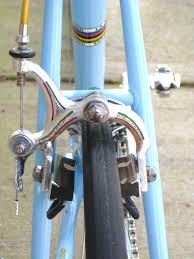Should I Have Disc or Rim Brakes on my Next Bike?
Rim brakes have been on bicycles for over 100 years and are a relatively light, mostly simple way to stop a bicycle. They are also somewhat easier for many people to work on and maintain, depending on the type of brake control method used, i.e. center or side pull caliper, or cantilever. Rim brakes are commonly found on bikes costing less than $1000 though even that is changing as more companies move to disc brakes on lower cost entry level models. The images below show examples of commonly seen rim and disc brakes. |
Colnago Side Pull Caliper Brake | GB Courier Center Pull Caliper |
|
|
Mountain Bike Cantilever | Modern Disc Brake |
|
|
When mountain biking became popular in the 1980’s a new type of brake, the disc brake became more relevant since it freed suspension designers from having to deal with wire cables and cantilever brake systems. Mountain biking put serious demands on brakes due to riding downhill gradients and disc systems provided the durability and stopping power needed. It took a long time for disc brakes to find their way onto Road bikes but for the past 5 years they have come into more common usage and have been UCI legal in World Tour races since 2018. So, how do disc brakes work and why would I want them over rim brakes? One advantage to disc brakes over rim brakes is their better all-weather performance, particularly in wet conditions, and for their excellent stopping power and superior speed modulation. The disadvantage to disc brakes for a long time was the significant weight increase ( up to 8 lbs in the early versions of 50 years ago ) and the potentially higher maintenance depending on which type of disc brake a bicycle has. Generally, a modern disc brake arrangement weighs about a pound more than a comparable rim brake setup, but for most riders except pro racers, that weight is usually not significant to enjoying a ride. Besides, a lot of pro riders began using discs for safety reasons, and advancement in design and technology continue to contribute to lighter brakes. The two main types of disc brakes are mechanical and hydraulic. Mechanical disc brakes are controlled by a cable ( the way rim brakes operate ) while hydraulic disc brakes are controlled by a fluid in a sealed line. Mechanical disc brakes operate by the cable pulling the brake pads toward the disc rotor, while the hydraulic version uses the fluid to push the pads toward the disc rotor. The main disadvantage to disc brakes is maintenance , particularly with hydraulic models. It is best left to a trained bike mechanic to provide brake bleeding when necessary and replacement of brake pads. Mechanical disc brakes are slightly easier to work on, but even so, there are things to be aware of before tackling maintenance on these as well. So, which is better, rim or discs; the Youtube clip below from the GCN Tech Show may help you decide. Find out what Oliver Bridgewater on GCN Tech chooses for his next road bike by watching! |




